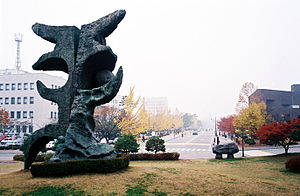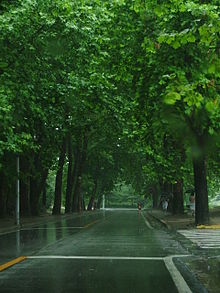- Chungbuk National University
-
Chungbuk Natl. University 충북대학교 
Motto Korean: 진리·정의·개척
Latin: NOVA APERIO
(University that Opens New things)Established 1951 Type National President Dr. Kim Seung-Taek Academic staff 709 (2005) Students 18,991 (2005) Undergraduates 14,539 (2005) Postgraduates 4,352 (2005) Location Cheongju, South Korea Campus Urban Colors Crimson Nickname 충대 (ChungDae) Mascot Bull Website www.cbu.ac.kr (Korean), http://www.cbnu.ac.kr/eng/ (English) Chungbuk National University Hangul 충북대학교 Hanja 忠北大學校 Revised Romanization Chungbuk Daehakgyo McCune–Reischauer Ch'ungbuk Taehakkyo Chungbuk National University (CBNU,CBU) is one of 10 Flagship Korean National Universities.
It takes its name, Chungbuk, from the common abbreviated form of the province's Korean name.Contents
Overview
Chungbuk National University is located in the southwestern part of Cheongju, which is the provincial capital of Chungbuk Province. The pastoral surroundings promotes a pleasant environment to pursue diverse academic degrees. The University is made up of 12 colleges with a total of 6 schools, 63 departments, and 6 graduate schools. In addition, there are 29 research institutes that serve as adjunct centers for the faculty research activities. Other supporting organizations include the University Libraries, the University Museum, the Center for Research Instruments and Experimental Facilities, the University Computer Center, as well as numerous others.
There are over 18,000 students currently enrolled in undergraduate and graduate programs at Chungbuk National University. Presently, the total number of faculty members is 644. CBNU welcomes students from all over the world to join in its academic experience. It has grown to become one of the leading educational and research institutions in Korea. As a cultural and intellectual center of Chungbuk Province, the University provides its students with superb educational programs, research facilities and up-to-date laboratories, and has many cooperative programs with its local communities and businesses. CBNU has made some notable advances.
Dongah-Ilbo newspaper ranked CBNU 2nd in the Korean Internet sector (1997). CBNU won an "Excellent University" award from the Korean Ministry of Education (1997) in various fields such as "educational reform in the information sector", "reform of school affairs", and "educational reform for extending student's freedom to choose his or her major field". CBNU is the only university that has been awarded the specialized program grant in the semiconductor and information technology area by the government of Korea. As an outcome, the College of Engineering won approximately US$25,000,000 from the government for the purpose of training quality manpower, as required in industries, by providing experience-based programs (1994–1999). The SchooI of Electrical Engineering and Computer Science has been awarded the Brain Korea 21 program with an annual multi-million dollar grant, while the Physics and Pharmacy research teams won big research grants as well.
The Health, Medicine, and Life Science Program first developed systematic interdisciplinary curriculum connecting and combining basic sciences and applied technologies. Osong, near Cheongju, will become the center for health, medicine and life science related government offices, industries and research institutes. CBNU will be a major element of this enterprise.
The Korea Science and Engineering Foundation (KOSEF) designated the Center for Advanced Horticultural Technology Development and Research as a Regional Research Center. KOSEF annually donate approximately $1,000,000 in grant money to the Center.
CBNU emphasizes the generation of revolutionary ideas based in advanced information systems. The super-speed computer network (ATM) was established for this purpose, and all students are eligible to get personal internet IDs. Most classrooms are equipped with ultra-modern multimedia devices, which include PCs, LCD projectors, and data viewers.
History
- History of CBNU (Chungbuk National University)
- The school first opened its doors as "Cheongju Junior Agricultural College" (청주초급농과대학) in 1951.
- At the time, it was operated by the provincial government of North Chungcheong. It became a four-year college in 1953, and was renamed simply Chungbuk Provincial College in 1956.
- In 1962, the national government merged it with Chungnam National University to create the short-lived Chungcheong National University.
- The two institutions were separated once again in 1963, but Chungbuk College remained under national control.
- A graduate school was established in 1968.
- On December 31, 1977, the college was renamed Chungbuk National University.
Undergraduate colleges
- Undergraduate colleges of CBNU (Chungbuk National University)
- College of Humanities
- College of Social Sciences
- College of Natural Sciences
- College of Engineering
- College of Law
- College of Education
- College of Commerce and Business Administration
- College of Pharmacy
- College of Medicine
- College of Veterinary
- College of Electronic and Computer Engineering
- College of Agriculture
- College of Human Ecology
Graduate schools
- Graduate schools of CBNU (Chungbuk National University)
- Graduate School of Humanities
- Graduate School of Social Sciences
- Graduate School of Natural Sciences
- Graduate School of Engineering
- Graduate School of Law(Law School)
- Graduate School of Education
- Graduate School of Commerce and Business Administration
- Graduate School of Medicine (Medical school)
- Graduate School of Pharmacy
- Graduate School of Veterinary
- Graduate School of Electronic and Computer Engineering
- Graduate School of Agriculture
- Graduate School of Human Ecology
- Graduate School of Management
- Graduate School of Public Administration
- Graduate School of Industry
Vision
CBNU has a well-defined vision[peacock term] and a well-founded strategy[peacock term]. This strategy is divided into 4 specialized fields : BT, IT, NT, and the high-tech fields of agriculture, forestry, and fisheries, (which are aligned with Osong Bio-health Technopolis and Ochang Science Industrial Park). CBNU's goal is to become a leading university in Korea, and to strengthen its competitive power in the world.
-
- Four Specialized Fields
-
- The information & Communication Field (IT)
- Selected to be a coordinating university for research in bio- information technology; now in charge of the Research Institute for Bio-information Technology project
- Established a super-speed computer network (ATM) and currently issues Internet IDs to all students for network use
- Up-to-date lecture rooms and multimedia rooms equipped with a full network system
- One-stop services for school affairs centering on user convenience
- Operation of a Cyber University and OCU
- The information Technology Biology Incubator was selected as an excellent institute by the Ministry of Information & Communication.
-
- The High-technology Field (NT)
- Selected as a hub university for regional research Selected as 1st place winner of the project New University for Regional Innovation supervised by the Ministry of Education & Human Resources Development College of Engineering supported by government funding in the form of 25.1 billion won Selected as the leading school for the program, Brain Korea 21 (BK21), which is assisting and supporting regional universities Owns a technology research institute and an education center jointly run by the university, research institutes, and companies with a total floor size for 137,000 square feet (12,700 m2) Ochang campus establishment plan
-
- The Health, Medicine, & Life Science Fields(BT) & Social Sciences
- Anti-pollution, high-value strategic area for the 21st century
- Cooperation with the health, medicine, and life science complex in Ochang
- Interdisciplinary studies connecting and combining basic sciences and applied technologies
- Regional Research Center for Bio Health Industry Development
- Developing a unified education program in relation to BT
- Education for industrial technicians and venture businesses
- Establishment of a health, medicine, and life science campus, as a long-term plan
- The prestigious Biomedical Systems Development Center was selected to be funded by the Ministry of Health and Welfare
- National crisis Management Research lnstitute(Hosted by Department of Public Administration)
-
- The Agriculture Forestry & Fisheries Fields
- Center for Development and Research of advanced Horticultural Technology
- Operates 5 high-tech greenhouse buildings, a horticultural cultivation field of 340 pyong (12,240 square feet)
- Annual support of 1 billion won from the Korea Science Foundation
- Technical education for each item determined by professor's meetings
- Cooperation with 8 research centers around the world, like the one at University of Calgary in Canada
Sister schools
The university maintains exchange relationships with 76 institutions in thirty countries[1]
- Sister schools (Date 19. 01. 2009)
- National University
- Seoul National University, Pusan National University, Chungnam National University
- Kyungpook National University, Chonnam National University,
- Chonbuk National University, Kangwon National University, Jeju National University
- Gyeongsang National University, Korea Air Force Academy, KISTII,
- Private University
- Yonsei University, Hanyang University, Dongguk University
- kookmin University, Sookmyung Women's University
- Local(Chungcheongbuk-do) University
- Korea National University of Education, Cheongju University, Seowon University
- Chungju National University of EDU, Semyung University, FarEast University
- Chungcheong College, Jusung College, Daewon Science College
-
- U.S.A
- University of Maine, St. John's University
- Colorado State University, Rutgers-The State University of NewJersey
- Washington State University, University of Nebraska-Lincoln
- Southern Illinois University-Carbondale, Idaho State University
- Nanjing Normal University, Xian Jiaotong University
- Gilim Science Academy, Huazhong University of Science and Technology
- Dalian University of Technology, Shanghai University
- Beijing Normal University, Yanbian University
- East China Normal University, Henan Polytechnic University
- Shen Zhen University, Beijing International Studies University
- Harbin Engineering University,Hunan Agriculture University
- Chinese Academy of Social Science
- Saint-Petersburg State University, Irkutsk State University
- Moscow Institute of Steel and Alloys,MISIS
- Vladivostok State University of Economics and Service
- Krasnoyarsk State University
- Krasnojarsk State Pedagogical University
- Krasnojarsk State Technical University
- Krasnojarsk State Institute of Economics and Trade
- Krasnoyarsk State Medical Academy
- Krasnoyarsk State Air-Space University
- Krasnoyarsk State Instituteof Arts
- Ibaraki University, Tokyo University of Agriculture and Technology
- Meiji University, Hokkaido University, Yamagata University
- University of Glasgow, University of Wales Cardiff
- University of Reading
- Warsaw University, Maria Curie-Sklodowska University
- University of Lodz
- Tashikent Nizami State Teachers Training Institute
- Tashkent State University of Oriental Studies
- Griffith University, The University of Queensland
- Benguet State University, Pampanga Agricultural College
- National Technical University of Ukraine, "Kiev Polytechnic Institute"
- Odessa National Maritime University
-
- Republic of South Africa
- University of South Africa
- Bishkek Humanities University
- University of Castile-La Mancha
- University of Hannover
- Kazakh Ablai khan University of International Relations and World Languages
- Universidad Catolica de Valparaiso
- Universidad Nacional de Cordoba
See also
- List of colleges and universities in South Korea
- List of Korea-related topics
- Education in South Korea
- Flagship Korean National Universities
Footnote
External links
Categories:- Universities and colleges in Chungcheongbuk-do
- Cheongju
Wikimedia Foundation. 2010.

